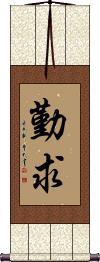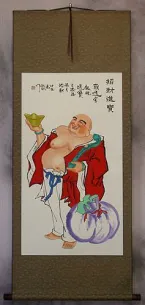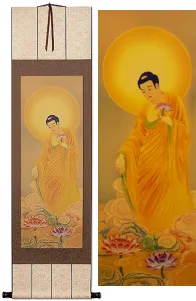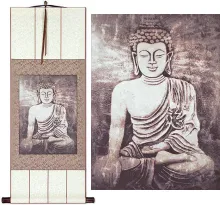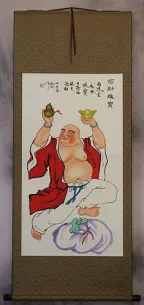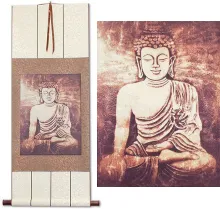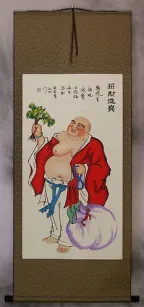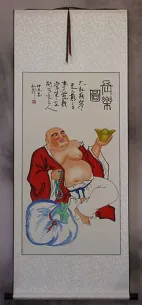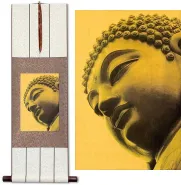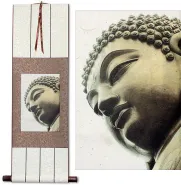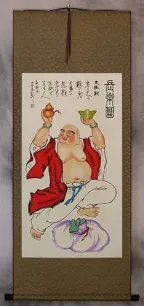Many custom options...
And formats...

Buddha Seeking in Chinese / Japanese...
Buy a Buddha Seeking calligraphy wall scroll here!
Personalize your custom “Buddha Seeking” project by clicking the button next to your favorite “Buddha Seeking” title below...
Buddha Seeking
The Middle Way
In the most basic translation, 中道 means road through the middle or middle road.
The expanded meaning can be moderation or the golden mean.
But if you are looking for this title, you are probably seeking the Buddhist definition, which is more complex.
中道 is the middle way or middle path of Buddhism. This has various interpretations. In general, it denotes the mean between two extremes and has special reference to the mean between realism and nihilism, or eternal substantial existence and annihilation.
The Buddha teaches that one should not take things to extremes. Don't be extremely evil and engage in debauchery and murder. But do not spend every waking out trying to be a perfect saint. Instead, take the middle path, try to help others, show loving kindness wherever you can, and try not to do harm. If you inadvertently harm another being, make amends if you can, and move on. Realize you are not perfect, but in time, a path of moderation lead toward proper living and enlightenment.
This in-stock artwork might be what you are looking for, and ships right away...
Gallery Price: $200.00
Your Price: $69.88
Gallery Price: $200.00
Your Price: $69.88
Gallery Price: $200.00
Your Price: $69.88
Not the results for Buddha Seeking that you were looking for?
Below are some entries from our dictionary that may match your Buddha Seeking search...
| Characters If shown, 2nd row is Simp. Chinese |
Pronunciation Romanization |
Simple Dictionary Definition |
菩薩 菩萨 see styles |
pú sà pu2 sa4 p`u sa pu sa bosatsu(p); bosachi(ok) ぼさつ(P); ぼさち(ok) |
More info & calligraphy: Bodhisattva(n,n-suf) (1) {Buddh} bodhisattva; one who has reached enlightenment but vows to save all beings before becoming a buddha; (n,n-suf) (2) High Monk (title bestowed by the imperial court); (n,n-suf) (3) (See 本地垂迹説) title bestowed to Shinto kami in manifestation theory; (surname) Mizoro bodhisattva, cf. 菩提薩埵. While the idea is not foreign to Hīnayāna, its extension of meaning is one of the chief marks of Mahāyāna. 'The Bodhisattva is indeed the characteristic feature of the Mahāyāna.' Keith. According to Mahāyāna the Hinayanists, i.e. the śrāvaka and pratyekabuddha, seek their own salvation, while the bodhisattva's aim is the salvation of others and of all. The earlier intp. of bodhisattva was 大道心衆生 all beings with mind for the truth; later it became 大覺有情 conscious beings of or for the great intelligence, or enlightenment. It is also intp. in terms of leadership, heroism, etc. In general it is a Mahayanist seeking Buddhahood, but seeking it altruistically; whether monk or layman, he seeks enlightenment to enlighten others, and he will sacrifice himself to save others; he is devoid of egoism and devoted to helping others. All conscious beings having the Buddha-nature are natural bodhisattvas, but require to undergo development. The mahāsattva is sufficiently advanced to become a Buddha and enter nirvāṇa, but according to his vow he remains in the realm of incarnation to save all conscious beings. A monk should enter on the arduous course of discipline which leads to Bodhisattvahood and Buddhahood. |
大乘 see styles |
dà shèng da4 sheng4 ta sheng oonori おおのり |
Mahayana, the Great Vehicle; Buddhism based on the Mayahana sutras, as spread to Central Asia, China and beyond; also pr. [Da4 cheng2] (surname) Oonori Mahāyāna; also called 上乘; 妙乘; 勝乘; 無上乘; 無上上乘; 不惡乘; 無等乘, 無等等乘; 摩訶衍 The great yāna, wain, or conveyance, or the greater vehicle in comparison with the 小乘 Hīnayāna. It indicates universalism, or Salvation for all, for all are Buddha and will attain bodhi. It is the form of Buddhism prevalent in Tibet, Mongolia, China, Korea, Japan, and in other places in the Far East. It is also called Northern Buddhism. It is interpreted as 大教 the greater teaching as compared with 小教 the smaller, or inferior. Hīnayāna, which is undoubtedly nearer to the original teaching of the Buddha, is unfairly described as an endeavour to seek nirvana through an ash-covered body, an extinguished intellect, and solitariness; its followers are sravakas and pratyekabuddhas (i.e. those who are striving for their own deliverance through ascetic works). Mahāyāna, on the other hand, is described as seeking to find and extend all knowledge, and, in certain schools, to lead all to Buddhahood. It has a conception of an Eternal Buddha, or Buddhahood as Eternal (Adi-Buddha), but its especial doctrines are, inter alia, (a) the bodhisattvas 菩薩 , i.e. beings who deny themselves final Nirvana until, according to their vows, they have first saved all the living; (b) salvation by faith in, or invocation of the Buddhas or bodhisattvas; (c) Paradise as a nirvana of bliss in the company of Buddhas, bodhisattvas, saints, and believers. Hīnayāna is sometimes described as 自利 self-benefiting, and Mahāyāna as 自利利他 self-benefit for the benefit of others, unlimited altruism and pity being the theory of Mahāyāna. There is a further division into one-yana and three-yanas: the trīyāna may be śrāvaka, pratyeka-buddha, and bodhisattva, represented by a goat, deer, or bullock cart; the one-yāna is that represented by the Lotus School as the one doctrine of the Buddha, which had been variously taught by him according to the capacity of his hearers, v. 方便. Though Mahāyāna tendencies are seen in later forms of the older Buddhism, the foundation of Mahāyāna has been attributed to Nāgārjuna 龍樹. "The characteristics of this system are an excess of transcendental speculation tending to abstract nihilism, and the substitution of fanciful degrees of meditation and contemplation (v. Samādhi and Dhyāna) in place of the practical asceticism of the Hīnayāna school."[Eitel 68-9.] Two of its foundation books are the 起信論and the 妙法蓮華經 but a larnge numberof Mahāyāna sutras are ascribed to the Buddha。. |
道交 see styles |
dào jiāo dao4 jiao1 tao chiao michitsugai みちつがい |
(place-name) Michitsugai Mutual interaction between the individual seeking the truth and the Buddha who responds to his aspirations; mutual intercourse through religion. |
大乘心 see styles |
dà shèng xīn da4 sheng4 xin1 ta sheng hsin daijō shin |
The mind or heart of the Mahāyāna; seeking the mind of Buddha by means of Mahāyāna. |
辟支佛 see styles |
bì zhī fó bi4 zhi1 fo2 pi chih fo byakushi butsu |
(辟支迦) (辟支佛陀) (辟支迦佛陀) pratyekabuddha, one who seeks enlightenment for himself, defined in the Lotus Sūtra as a believer who is diligent and zealous in seeking wisdom, loves loneliness and seclusion, and understands deeply the nidānas. Also called 緣覺; 獨覺; 倶存. It is a stage above the śrāvaka 聲聞 and is known as the 中乘 middle vehicle. Tiantai distinguishes 獨覺 as an ascetic in a period without a Buddha, 緣覺 as a pratyekabuddha. He attains his enlightenment alone, independently of a teacher, and with the object of attaining nirvāṇa and his own salvation rather than that of others, as is the object of a bodhisattva. Cf. 畢. |
三種灌頂 三种灌顶 see styles |
sān zhǒng guàn dǐng san1 zhong3 guan4 ding3 san chung kuan ting sanshu kanjō |
Three kinds of baptism: (1) (a) 摩頂灌頂 Every Buddha baptizes a disciple by laying a hand on his head; (b) 授記灌頂 by predicting Buddhahood to him; (c) 放光灌頂 by revealing his glory to him to his profit. (2) Shingon has (a) baptism on acquiring the mystic word; (b) on remission of sin and prayer for blessing and protection; (c) on seeking for reward in the next life. |
印佛作法 see styles |
yìn fó zuò fǎ yin4 fo2 zuo4 fa3 yin fo tso fa inbutsu sahō |
An esoteric method of seeking spirit-aid by printing a Buddha on paper, or forming his image on sand, or in the air, and performing specified rites. |
上求佛道下化衆生 上求佛道下化众生 see styles |
shàng qiú fó dào xià huà zhòng shēng shang4 qiu2 fo2 dao4 xia4 hua4 zhong4 sheng1 shang ch`iu fo tao hsia hua chung sheng shang chiu fo tao hsia hua chung sheng jō gu butsu dō ge ke shūjō |
seeking the path of the Buddha above, and saving sentient beings below |
The following table may be helpful for those studying Chinese or Japanese...
| Title | Characters | Romaji (Romanized Japanese) | Various forms of Romanized Chinese | |
| Buddha Seeking | 勤求 | gongu | qín qiú / qin2 qiu2 / qin qiu / qinqiu | ch`in ch`iu / chinchiu / chin chiu |
| The Middle Way | 中道 | chuu dou / chuudou / chu do | zhōng dào zhong1 dao4 zhong dao zhongdao | chung tao chungtao |
Successful Chinese Character and Japanese Kanji calligraphy searches within the last few hours...
